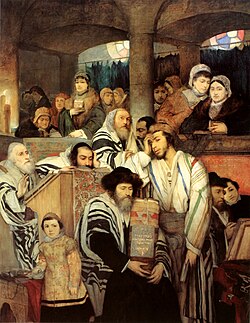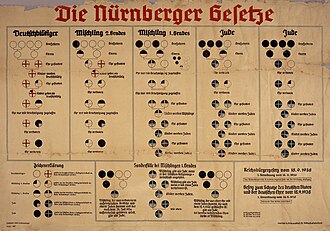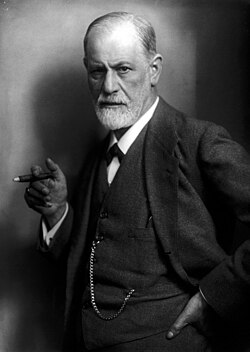
The German Minority Census (1939) was a census of minorities which was taken in Germany and German-occupied lands of Central Europe in May 1939. This means that in addition to modern-day Germany, it included Austria, Czechia, Slovakia and pockets of northern Poland, Kaliningrad and Lithuania. The purpose of the minority census was to try and work out how many people in the expanding Third Reich had at least one Jewish grandparent. The minority census was ancillary to a national census and was filled out using a separate card that was distributed with the main census. These Ergänzungskarte or supplementary cards were later collated together and sent to the Reich Genealogy Office where they could have been used for identifying those of Jewish heritage as part of the Holocaust. They have survived down to the present day as an important genealogical record of the Jewish minority within Germany and adjacent lands on the eve of the Second World War.[1]
Research your ancestors on MyHeritage
German Minority Census (1939) chronology of eventsGerman Minority Census (1939) chronology of events
When the Nazis seized power in Germany early in 1933, there were approximately half a million Jewish people living in the country.[2] Therefore the Holocaust which would occur during the Second World War was directed for the most part against Jewish people who lived in lands which were conquered or otherwise annexed by the Germans from March 1938 onwards. For instance, the Anschluss with Austria at this early date brought the large Jewish community of the city of Vienna under Nazi rule. A substantial enough number of Jewish people lived in what was then Czechoslovakia and which was taken over in March 1939.[3] The vast majority of the Jewish people who suffered under Nazi oppression, though, lived in Poland or other parts of Eastern Europe like Ukraine, Lithuania and Belarus. It was therefore a goal of the Nazis as they took over more and more parts of Europe to identify the Jewish populations that came under their control, in order to first rob and persecute these Jewish people, and later to systematically mass murder them.[4]
The German minority census of 1939 was part of these persecutory efforts. A census of Germany was due by the late 1930s. There had been only one census taken since 1925, which was held in June 1933 right after the Nazis came to power. With six years having elapsed since then, a new census was taken on the 17th of May 1939. In addition to Germany itself, this covered Austria, parts of Czechoslovakia (though this was divided into territories that were directly annexed into Germany and regions which were governed as occupied lands) and several other recently acquired territories, like the city of Memel in Lithuania. Therefore the standard census of 1939 showed an overall increase in the population of Germany of around 21%.[5]

The census was accompanied by an Ergänzungskarte or supplementary card. These required those completing the census to provide details on whether or not anyone in the household was Jewish or had a Jewish grandparent. This was in line with elements of the Nazi Mischling Test, a set of guidelines introduced since 1933 through which rules were set down for the identification of Jewish people. Within this there were several clauses which discussed how many Jewish grandparents a person had to have in order to qualify as being fully Jewish under the Nuremburg Laws.[6]
The supplementary cards, which made up the minority census, were gathered along with the standard census returns in 1939. The information about ‘Jewish households’ was collated and sent to the security services and other departments. Later they were sent separately to the Reich Genealogy Office in Berlin. They were held there by 1942, the year the Holocaust began in the six death camps after the Wannsee Conference of January that year, though the Holocaust in the shape of the Einsatzgruppen death squadrons on the Eastern Front and the starvation tactics used in the Warsaw and Krakow ghettos was already underway prior to this. The minority census cards survived in the Reich Genealogy Office down to the end of the war, possibly being used to identify Jewish people throughout Austria, Czechoslovakia and other conquered lands in the interim.[7]
Later the cards passed into the possession of the government of communist East Germany before being deposited in the new German Federal Archives after German reunification in 1990 at the end of the Cold War. They are not 100% complete. It is believed that around 87% of the cards have survived. Those for the provinces of Thüringen and Rhein and the districts of Erfurt and Minden are missing, along with those for a number of districts in Bavaria. Why these might have become separated from the bulk of the collection is not clear. There are around 410,000 entries for Jewish households in all.[8]
Extent of migration associated with the Germany Minority Census (1939)Extent of migration associated with the Germany Minority Census (1939)

The German minority census was not responsible for any migration. Instead it is reflective of the creeping level of persecution of the Jewish people and other minorities within the Third Reich. Many people were fleeing from Nazi rule as they expanded their territorial dominions in the late 1930s. For example, the famous psychoanalyst, Sigmund Freud, had left his native city, Vienna, in the summer of 1938, not long after the Nazis took control of Austria. Thus, in the short run, if anything the minority census was demonstrative of the reasons why Jewish people were migrating out of Central Europe to places like London in Britain, as in Freud’s case, or to the United States. Many were unable to pay to leave, and most countries were reluctant to offer asylum during these years, unaware of the genocide which the Nazis would unleash in years to come across Europe, resulting in the deaths of approximately six million Jewish people, many of whom were identified in the minority census of 1939.[9]
See alsoSee also
Explore more about the German Minority Census (1939)Explore more about the German Minority Census (1939)
- German Minority Census, 1939 records collection on MyHeritage
- Jewish Holocaust Memorials and Jewish Residents of Germany 1939-1945 records collection on MyHeritage
- Worldwide Jewish Burial Registry from JewishGen records collection on MyHeritage
- Jewish Genealogy with JewishGen.org at Legacy Family Tree Webinars
- What's New in Austrian and Czech Jewish Genealogy at Legacy Family Tree Webinars
References
- ↑ https://www.ushmm.org/online/hsv/source_view.php?SourceId=42011
- ↑ https://encyclopedia.ushmm.org/content/en/article/germany-jewish-population-in-1933
- ↑ https://www.chipublib.org/timeline-wwii-germany/
- ↑ https://encyclopedia.ushmm.org/content/en/article/introduction-to-the-holocaust
- ↑ ‘The Demography of War: Germany’, in Population Index, Vol. 14, No. 4 (October, 1948), pp. 291–308.
- ↑ Thomas Pegelow, ‘Determining “People of German Blood”, “Jews” and “Mischlinge”: The Reich Kinship Office and the Competing Discourses and Powers of Nazism, 1941–1943’, in Contemporary European History, Vol. 15, No. 1 (February, 2006), pp. 43–65.
- ↑ ‘Germany’, in The American Jewish Year Book, Vol. 42 (1941), pp. 345–349.
- ↑ https://www.ushmm.org/online/hsv/source_view.php?SourceId=42011
- ↑ https://www.ushmm.org/online/hsv/source_view.php?SourceId=42011

